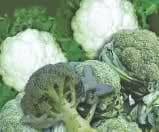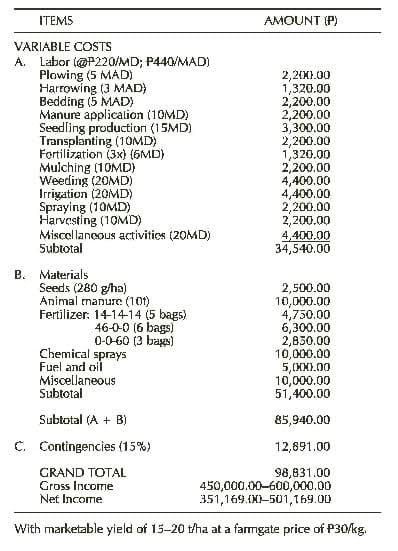 Broccoli (Brassica oleracea L. var italica Plenck) is one of the most expensive vegetables in the Philippines. It can be boiled, steamed, stir fried, or sauteed with other vegetables. It is fairly high in vitamin A, vitamin C, calcium, iron, thiamine, riboflavin, and niacin.
Broccoli (Brassica oleracea L. var italica Plenck) is one of the most expensive vegetables in the Philippines. It can be boiled, steamed, stir fried, or sauteed with other vegetables. It is fairly high in vitamin A, vitamin C, calcium, iron, thiamine, riboflavin, and niacin.
Cauliflower (Brassica oleracea L. var botrytis) is another popular crucifer grown mainly in cooler areas. It is steamed, stir fried, or pickled.
Broccoli and cauliflowers grow well in mid- and high- elevation areas like in Benguet, Ilocos Sur, and Bukidnon throughout the year. These crops can be planted in most soils but clay loam to sandy loam is best.
Land Preparation
Prepare the land thoroughly by plowing and harrowing several times. In low and mid elevation areas, make deep furrows 0.5 m wide. In high elevations, prepare beds 0.75-1.0 m wide. Apply 1 Kg fully decomposed chicken manure and 300 g carbonized rice hull/m2. Incorporate thoroughly with the soil.
For single row planting, make holes 0.3 m between hills, and for double row planting, 0.3 m between hills and 0.4 m between rows. Wet the holes, apply 10 g 14-14-14 in each hole, then cover lightly with soil.
Seedling Production
Prepare 1.0 m wide seedbeds at any convenient length. One hectare would require 50-70 m2 of seedbed. Incorporate manure and rice hull ash or wood ash. Line sow 280 g/ha of seed with furrows across the bed 7-10 cm apart. Sow thinly to prevent damping-off. Mulch with rice hull or grass clippings and water regularly. Provide nylon net tunnel as shade and rain barrier. Spray with pesticides when needed. Expose to full sunlight one week before transplanting. The seedlings are ready four weeks from sowing.
Transplanting
Water the seedbeds and gently uproot the seedlings. Transplant in rows 0.5-0.75 cm apart and 0.3-0.5 m between plants. Apply basal fertilizer at 10 g 14-14-14/hill. Irrigate before and after transplanting. Mulch with rice straw, rice hull or plastic to prevent weed growth and conserve soil moisture. It is best also to intercrop with bunching onion, bulb onion, garlic, kutsai, tomato, marigold, and other crops to minimize insect pests.
Fertilization and Weeding
Side-dress with urea (46-0-0) at the rate of 5-10 g/plant 2-3 weeks after transplanting with 10 g/hill of 2:1 mixture of 46-0-0 and 0-0-60. Fertilize only after weeding. Tea manure may be applied weekly as source of micronutrients. To prepare, soak 3/4 sack cow/ horse manure in a plastic drum filled with 189.25 L water for seven days. Fermented plant juice may also be used every two weeks to boost plant vigor. To prepare, mix equal parts of chopped actively growing plant parts and molasses or brown sugar. After one week of fermentation, extract the juice and apply as foliar fertilizer at 1 tbsp/ 3.785 L water.
Irrigation
During the dry season, irrigate before transplanting. Repeat every 7-10 days (furrow irrigation) or 2-3 times/week (sprinkler irrigation). Mulching helps minimize irrigation frequency.
Pest and Disease Management
Diseases/ Insect Pest —– Recommendations
Damping-off– Avoid overcrowding and too much watering in seedbeds; drench with Captan solution.
Black rot– Spray fungicides at the onset of disease; crop rotation
Soft rot– Remove and bury infected plants; crop rotation.
Diamondback moth– Avoid monocropping; remove debris of previous crop; spray with Bacillus thuringiensis and pesticides such as Fibronil.
Cabbage looper– Spray with hot pepper/tobacco extract, or pesticides.
Cabbage webworm– Spray with hot pepper extract or pesticides.
Aphids– Spray with soap solution or pesticides.
Harvesting
Harvest when curds are well formed. Include portions of stem and leaves. If possible, harvest early in the morning and avoid exposure to high temperatures to maintain good curd quality. Use top icing (placing of a 2- to 4-in layer of crushed ice over the top of pallets of precooled produce) to prolong shelf life.
Cost and Return Analysis Per Hectare

For more information, Please contact:
The Executive Director
PCARRD, Los Banos 4030, Laguna
Tel Nos: (049) 536-0014 to 20; 536-5907
Fax No: (049) 536-0016/ 536-7922
Email: pcarrd@pcarrd.dost.gov.ph
Website: http://www.pcarrd.dost.gov.ph
Source: www.dti.gov.ph
Do you like this business idea? then please consider subscribing to our PINOY BISNIS ![]() RSS feed. You can also subscribe by email and have new articles sent directly to your inbox. (Once you entered your e-mail address, you need to login to your e-mail account and click the link to confirm your subscription).
RSS feed. You can also subscribe by email and have new articles sent directly to your inbox. (Once you entered your e-mail address, you need to login to your e-mail account and click the link to confirm your subscription).
Great Share, Thank you so much Sir, you’ve done great,. I hope today the Broccoli and Cauliflower Production Guide will help the readers and also will get numerous ideas about this particular topic very well. Just appreciating your effort.
Awesome Information in the post
do you have any of trichoderma sp. from UPLB to control damping offa as the same time organic fertilizer.
where to buy?
This post really shows some incredible thing about Cauliflower and broccoli. And the existing features and contents of this post really makes me crazy about it. Thanks for sharing some awesome some and authentic thing.